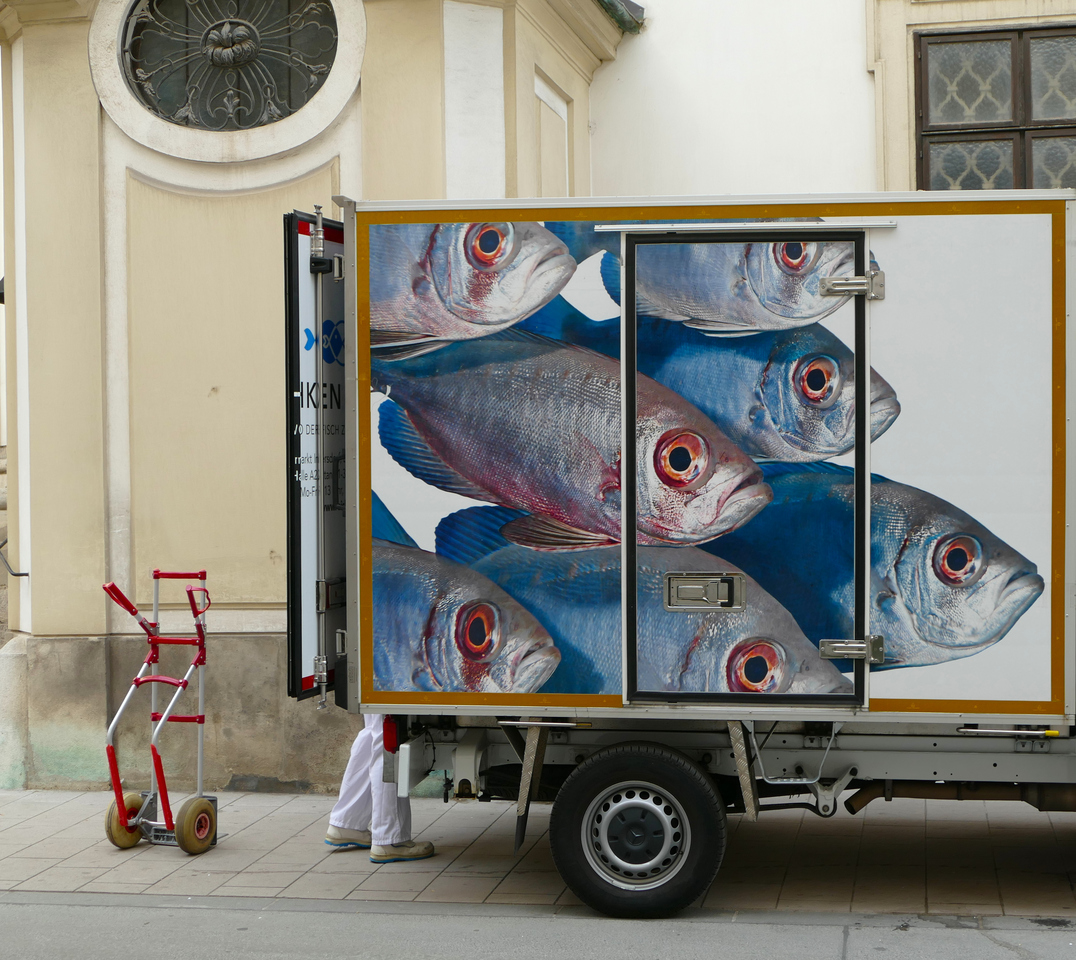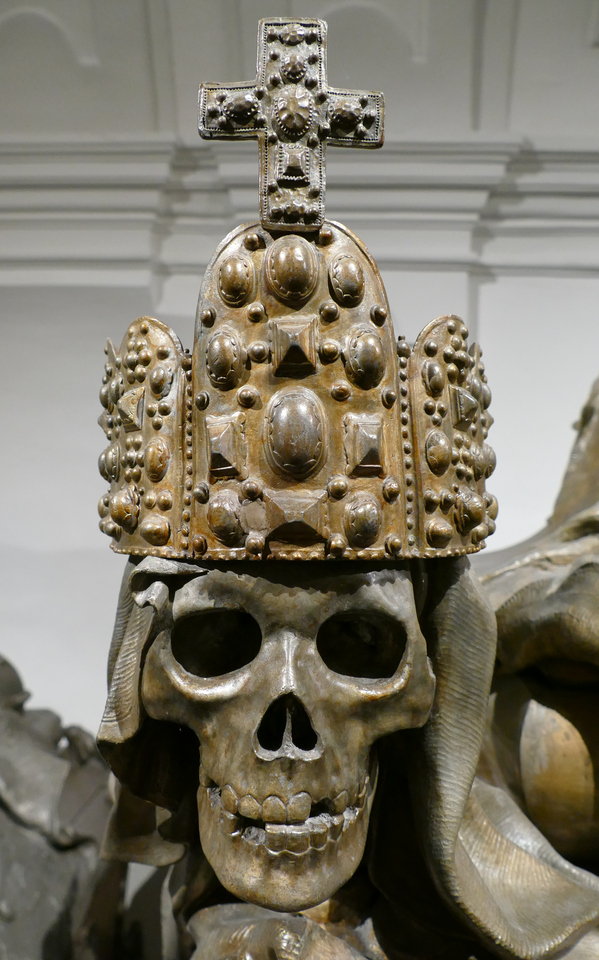We headed for the nearby Naschmarkt for breakfast, settling on Café Do-An. I had the large Viennese breakfast with an Espresso Doppio, Sarah had a hot chocolate, fresh-squeezed orange juice, and a croissant. When I came to Vienna, I was all worked up to start a fight about "real coffee:" the Viennese don't even make "coffee" as North Americans know it, they have this massive coffee haus culture ... and all they make anywhere, ever, is Espresso. That's not coffee, and I haven't been a fan of espresso in North America. I couple days drinking Espresso Doppios in Vienna and I'm willing to forgive them. I would still argue a little, but it's more a quantity thing: I'm used to picking up a big cup of coffee and drinking it for a while, whereas even a Doppio (a double) is minuscule (and expensive, generally €4.50 or around $6.50CA at current rates) and lasts me about three minutes. But damn, they're flavourful and I enjoy them.
photo: Not much to do with Vienna, but shot it today and it's one of my favourites of the trip

Our first stop of the day was what my guidebook calls the "Freyung Passage," whereas Google Maps and the building itself call it the "Ferstel Passage." It seems the adjacent public square is called "The Freyung," and the passage is through Palais Ferstel ... Imagine an arcade running through the middle of a building, possibly built by someone who had just finished building a church around 1750. They used stone with arches and gloriously vaulted ceilings, with small elegant stores facing into the space all the way along - and a pause in the middle for a water fountain under a skylight. We've seen a number of lovely alleyways, and even a couple very nice arcaded hallways, but this one is the best known in the city for a reason.
From there we attempted to follow one of the city walks laid out by my guidebook. Between the weird behaviours of Google Maps on our phones and us occasionally getting distracted and going off track, we never did quite finish the walk. But we saw lots of lovely parts of Vienna.
We decided to walk to the Votivkirche fairly near where we were. And we came across THE PIPE. This appears to be about 1.5km of 30cm diameter pipe running through northwest Vienna inside the Ringstraße ... although without seeing either the point of origin or the destination, my estimate of the length is dubious. This is not subtle: mostly it runs beside the road, on three metre tall pylons. But to make sure you don't stop noticing it, it zigs and zags. And goes through the Votiv Park, sometimes on the pylons, sometimes on the ground. Sarah found a TikTok video of a song called "WTF is the pipe in Vienna" or something similar, but it was just a song with swearing that didn't actually answer its own question ...
The Votivkirche is a bit strange. It was built from 1850 to 1875, but in a much older style: it's meant to look like a church from 1400 or so, and mostly succeeds both inside and out. Although we did spot some very small and peculiar details. The first I noticed was the carved figures of saints around the doors. There were lots, and they're in the typical poses of blessings, but a couple of them had very fine patterned detail carved into the cloth of their robes - something I've never seen on any other church (and I've seen a LOT of churches). That and the artwork in the stained glass being more modern than expected were the only things we really noticed. The existence of the stained glass was interesting: most churches in Vienna lost their stained glass to bombing in the Second World War, and it's almost uniformly been replaced by pastel-hued squares. It looks nice, but isn't as interesting (or as spiritual/religious) as the originals would have been. But Votivkirsche stands out for still having an almost complete complement of original (or restored?) stained glass. You don't realize how much you've been missing it until you see it again ...
Our next stop was Minoriten-Kirche. It's old, but small compared to the others we've visited, and it wasn't as interesting to me.
Next up was the "Kaisergruft," the crypt where a large number of Austria's old royalty were buried. The sign on the front says "Kapuzinercruft," telling you which group takes care of the place. The organization's logo is a stylized skull topped with a crown, and it's pretty damn eye-catching. Once you go in, you find out where they got this: one of the many (many!) incredibly ornate caskets boasts a particularly memorable skull-with-crown that became their symbol. It's considered a church and you're supposed to be respectful (I'm not advocating otherwise), but I'm imagining telling royalty on their death-bed "in 150 years, monks will charge money so tourists can see a decorated box holding your corpse." It was morbid and utterly fascinating: some of the caskets have skulls and crossbones, many have skulls, many have a crucified Jesus, many had cherubs weeping, etc. Later ones were actually somewhat more tasteful, although still ornate. There were fresh flowers on a surprising number of them - although Sisi's casket (remember Sisi from yesterday?) had by far the most flowers.
photo: The above-mentioned skull-with-crown

Sarah has come down with a cold ... and is going to Tosca tonight and Salzburg tomorrow by train, for a bus tour to sing the hills alive with music (neither of which appealed to me). The end result is that I'm on my own for 24+ hours.
My first step of the evening was to run off to Beaver Brewing, which probably gets mentioned more than any other micro-brewery when you search for the "best" in Vienna. In hindsight, I should perhaps not have been surprised to find that a place called "Beaver Brewing" was run by a former Michigander. So I ended up eating Pulled Pork Mac and Cheese (good - and very filling - but not outstanding). They do flights (the first time I've thought to ask), with a limitation: if you order the flight of six, you don't get to choose - you get the first six beers on the menu. Or you can order the flight of nine, which is every beer they make (except the very expensive cask-aged sour ale at the end of the list). And since the dark stuff was at the end of the list and a flight of nine was €12.50 ... Okay, I'm in.
As it turned out, not a huge success, although interesting. Their tasting notes referred to both of the IPAs (India Pale Ales) as being "dank." I think the brewer has been away from the North American continent too long: "dank" now means something that makes swamp water taste good. These are only a little bit "dank." Out of nine beers, the only one I liked was "Bad Leroy," an "Imperial Brown Ale." Brown Ales are hit-or-miss for me: the best are sort of like stouts but somewhat lighter, and that can really work for me. And I've had plenty of "imperial" stouts (for the non-beer fans among you, just think "high alcohol content"), but I've never seen an "Imperial Brown Ale" before, so this was really interesting.
I'm bemused to say that I think I was happier at Golser last night: their "dark" beer was ... well, not nearly so dark as I hoped, but nevertheless lovely, and their Shandy was very good - and their food was also very good.
I took Tram D back toward the Ringstraße, to the Parlament (sic) stop - where I got off and walked to MetaLab, one of the city's several maker spaces. Notably, of the two I emailed, this one responded and said helpful things - the other never responded at all. I got an English language tour by a comedy duo of twenty-somethings. The space is well equipped - although not well enough equipped to provide me with 120v (I had hoped to charge my toothbrush, which turns out to NOT accept 240v ... yup, a very weird request). But they did have a USB-A-to-mini cable, so I was able to get the data off my ancient GPS. (Hey - it makes much better tracks than a phone. It's also more annoying. <sigh>)
I hung around on the couches in the lounge afterwards, and participated in conversations about technology, American politics, and compound words in German. One of the people there who had essentially flawless English (they all spoke it well, but the rest had slight accents) seemed to be the only native Viennese person, and he claimed he got two languages for free growing up. He was also a huge fan of German compound words, one of his favourite examples being "Krankenwagen" which is a compounding of "Kranken" ("sick" or "suffer") and "wagen" which you can probably figure out. Google Translate says "Krankenwagen" is "Ambulance," but that disguises the language's tendency to mash multiple words together into one incredibly long word that non-German speakers have to translate piece by piece, desperately having to figure out where the breaks should be ... (this is the voice of previous experience, it's a long story that goes back to my employment with Domtar in 1990 when I was given a German-English dictionary and a set of blueprints ...).
I'm afraid I also mis-gendered one of the people I was talking to. Which is a sorry thing, because I quite liked her - but my brain looked and saw/heard a male, and chose to drop the previous gendering hints it had received of other people calling her "her." <sigh> And in that place, with those people, I should have been saying "they" or "their" if there was any doubt at all. Nothing makes you feel old like totally fucking up modern conventions that didn't exist when you were young. My only consolation (and it's not much of one) is that when they're 60, they'll need an interpreter to understand the conventions of the people 30 years younger than they are ...
I asked about THE PIPE, and was told it was there to pump water out of the excavations for the metro U5 line. I asked why not put it into the sewer? Well, it was too much volume for the sewer and/or the water treatment plant. So ... they're pumping it straight into the Donau River(!). Or so this person told me - he appears to be backed up by Reddit. Sarah did a bit more research, which again points to excavation of the U2 and U5 junction project, and that the pipe will likely be there through 2026.